|
| Author |
Message |
Ntwadumela
Member
|
# Posted: 23 Oct 2022 11:05 - Edited by: Ntwadumela
Reply
I have a small fan motor that I want to create a small wind generator to supplement my small solar but I don’t know much about wires except positive and negative. This motor has six wires. I need to know which wires I can eliminate and, honestly, any other help in this getting this thing plan up and running. I’m pretty sure I can figure out the mechanical part of this, but its the electrical stuff I am stumped about.
Can someone please help me get started like I am a six year old?
Thanks in advance for any help anyone can offer.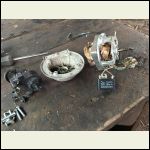
Fan motor1
| 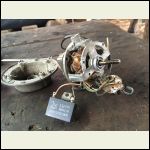
Fan motor2
| 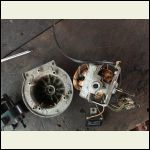
Fan motor3
|  |
|
|
Ntwadumela
Member
|
# Posted: 23 Oct 2022 11:18
Reply
I have a feeling that little black box has the wires I need but want to be sure. Also I guess I need to figure out a way the house this thing properly and hook it up to a blade and stand and make sure it turns in the opposite direction that the original fan went to get the generator effect, (right?).
|
|
gcrank1
Member
|
# Posted: 23 Oct 2022 14:58
Reply
Imo, you are spittin into the wind....that looks far too small to me, but:
1)what are the specs on the motor?
2)what charge control you are thinking of running the output through?
3)what is your battery bank?
4) what kind and size of blade assembly are you thinking of using?
|
|
Ntwadumela
Member
|
# Posted: 23 Oct 2022 15:17
Reply
I had not thought of all that. I will send you what I see.
I really just want something to keep a little more pep in the batteries when the sun is gone. I have a very small solar setup for phones and tablets and can charge my cordless drill as well. 200w of panels
I can’t find any more specs on the motor other than what is on the little black box in the “fan motor 2†photo from the first post.
Not really looking for a lot of power. Just want to learn the basics and give a try. Thanks for the your time, brother. I really appreciate it.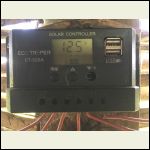
EBD6EA6B4F7249519.jpeg
| 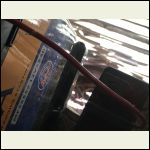
6B75E8607A8D43CD8.jpeg
|  |  |
|
|
Ntwadumela
Member
|
# Posted: 23 Oct 2022 15:22
Reply
Oh!
A smaller battery is a 12v 9ah
bigger one is 12 55ah
|
|
Fanman
Member
|
# Posted: 23 Oct 2022 15:42
Reply
That motor won't work as a generator. It's a 110VAC shaded-pole motor wired for different speeds. The black box is a capacitor.
To use a motor as a generator, it needs to be a permanent magnet motor, like most DC motors. Some people convert ceiling fan motors by replacing the rotor with an array of magnets on the shaft and running the AC output through a rectifier to get DC, but that won't work with this type of motor.
|
|
Ntwadumela
Member
|
# Posted: 23 Oct 2022 15:51
Reply
Ah!
So I should search for a different one. Preferably a bigger ceiling fan motor which I can convert to dc with magnets and a rectifier. I have seen a video on that but did not fully grasp it as they never really explain anything.
Thanks for my first lesson, sir. On my way to being and electrical engineer! 
|
|
gcrank1
Member
|
# Posted: 23 Oct 2022 17:31 - Edited by: gcrank1
Reply
Have you watched a big windplant spinning? The rotors are large dia., catch a lot of wind (swept area?) and spin sorta slow. The gearhead in them makes the generator part go faster than the rotor speed.
Anything you try to build that doesnt make the armature of whatever motor go faster than the 'blades' do wont put out enough to do much.
Imo, you are far better off going bigger on your storage (battery capacity) and more panels to feed that bat-bank than messing about with the serious mechanical and electrical issues of a windplant.
One thing often overlooked is that most folks cant bet one high enough to be in 'the real wind' and the gauge wiring on low voltage needs to be pretty big to go the distance 'down and over' to the end use. The line losses will kill the output.
Fwiw, about 30 some years ago I messed about with a small scale windplant based upon a dc perm magnet motor; made my own gearhead at 3 or 4:1, carved my blades, etc. I could get a 12v car clearance lightbulb to brighten up on a very windy condition. In gusts it would go from off to glow to brightish to glow to off. It wouldnt ever do anything to charge a battery.
Educational? Yes
Time consuming? Yes
Effective? NO
YMMV
|
|
|
Ntwadumela
Member
|
# Posted: 23 Oct 2022 18:24
Reply
Wow. That sounds like serious business! Maybe I will just scrap the idea and go with your advice on more bats and panels. I have enough work to do living on a homestead to lose time trying to reinvent the fan. I had no idea it was so complicated. I guess that’s why not many people do it. Thanks brother.
... I always wondered why those big blades turned so slowly...
|
|
gcrank1
Member
|
# Posted: 23 Oct 2022 20:19
Reply
You got it! Super 'labor intensive'; if it was easy Everybody would be doing it.
At least solar is not mechanically intensive, if possible ground mounts are way easier to do and maintain the array(s) than roof mounts or pole mounts and panels are getting better and less expensive than ever before. At this point the battery storage is pricey but folks can get started, learn and make early mistakes with 'leisure' or 'marine' Lead Acid bats before growing into LFP, or maybe soon the next new battery technology that will change the world of solar-electric.
Your 200W of array is your starter kit, waayyy better than the 15W I started with!
From your pic I see that '55Ah' battery is a 'starting battery'. NOT the kind you need for solar at all. All you likely get out of it is maybe 15Ah. The only thing it has done is allow you to get 'the system' up and running. You need to feed your solar from the controller into at least a 100Ah 'marine deep cycle' battery; that will gain you lots more Amp Hours/Watts. But be aware that with the old-school, Lead Acid bats like that you can only use a MAX of 50% of the rated power, so,a 100Ah bat nets you a MAX of 50Ah but will live a lot longer if you only use a normal discharge of 25-30Ah's out of it.
|
|
Ntwadumela
Member
|
# Posted: 24 Oct 2022 09:01
Reply
Yes, I am starting to figure out a lot of stuff and have made some mistakes already that cost me 3 of those starter bats.
Would you say that batteries or solar is more important overall, as far as what you buy more of or is it all relative? As it stands, my controller often shuts down during the day as (I guess) the battery can’t take anymore. I just let the bat drain a bit with charging and hook it back up for now.
Yeah, would love to afford one or two of those big marine things- oh!- also, I think it’s better to have more smaller batteries and a few big ones, in case one goes bad, you don’t lose as much.
Any advice on those points, my brother?
Really appreciate the knowledge you are dropping.
|
|
mj1angier
Member
|
# Posted: 24 Oct 2022 11:44
Reply
This might get you headed down the right path
https://sciencing.com/use-treadmill-motor-wind-generator-7704417.html
|
|
Ntwadumela
Member
|
# Posted: 24 Oct 2022 12:28
Reply
Quoting: mj1angier This might get you headed down the right path
Thanks you very much. I will check it out.
|
|
ICC
Member
|
# Posted: 24 Oct 2022 12:59
Reply
Quoting: Ntwadumela As it stands, my controller often shuts down during the day as (I guess) the battery can’t take anymore. I just let the bat drain a bit with charging and hook it back up for now.
What kind of controller.... a solar charge controller, is that correct? Brand and model will help anyone trying to help.
You and all solar users want the batteries to get full every day, especially with lead-acid batteries. A good charge controller does NOT need disconnecting from the batteries. In fact, that can be detrimental.
|
|
ICC
Member
|
# Posted: 24 Oct 2022 13:10
Reply
Quoting: Ntwadumela I think it’s better to have more smaller batteries and a few big ones, in case one goes bad, you don’t lose as much.
The best is to learn more about solar or any alternative energy system, batteries, etc (the whole ball of wax) before sinking much money into it. That way your losses will be few and more likely due to unforeseen outside forces which we have little or no control over. Lightning strikes, theft, and so on)
Building a solar-powered battery storage system has been done many times. There is no need to go through a learn-by-trial-and-error methodology anymore.
I know enough about wind generation that I know that most locations do not have enough consistent wind to bother with.
|
|
Ntwadumela
Member
|
# Posted: 24 Oct 2022 13:10
Reply
Good to know, brother. Here it is (attchment) and I was wondering about that as well. It should work on its own to regulate. Perhaps the power from the panels (volts) are too much for the controller? They are rated 18v...
Some cheap chinese brand I bought on a budget. It goes to 14.4 and stops flashing the sign that it is sending power to the battery... then it shuts off and the lights connected to the “load†start flickering on until I disconnect the solar from the controller.
|
|
Ntwadumela
Member
|
# Posted: 24 Oct 2022 13:19
Reply
Quoting: ICC The best is to learn more about solar or any alternative energy system, batteries, etc (the whole ball of wax) before sinking much money into it.
Not much chance of that where I live - losing much money.- since there there is very little available here in this unknown town of 40,000, the largest town on this side of the country. I think there are maybe two cordless tools available and I must search all six hardware stores to find one.
I did attempt to learn as much as I could online but have found the forums far better for learning anything energy or any other subject. Comments and small details like yours, my brother, are often left out. And usually precise links are provided to help weed out the crap sites.
|
|
Fanman
Member
|
# Posted: 24 Oct 2022 18:24
Reply
Actually, an old cordless drill, as long as it has a permanent magnet DC motor (not a brushless motor), might work as a generator provided its gearbox can hold up to being back driven. It would take some R&D work, though.
People have also used car alternators turned by windmills or water wheels. The advantage there is that with a modern alternator with built-in regulator, all the electronics to charge a 12V battery are already there.
But unless you live in a mostly cloudy locale with steady winds, cleaning up and expanding your solar system is probably a better approach.
-----------------------------------------
The specs for your solar controller should tell you what the maximum input voltage is. If you exceed it, I can well imagine it would shut down to avoid damage.
|
|
gcrank1
Member
|
# Posted: 24 Oct 2022 20:00
Reply
Your 18ishv panel output is normal for a nominally 12v system, as is the 14.4v from the solar charge control (scc). The higher voltages are needed to actually get the battery charged.
The scc likely has 2 input terminals from the array, 2 output that should go to the battery bank (even if it is only 1 bat it is still 'the bank') and 2 outputs that are labeled 'load'. Do Not use the 'load' to run to the bat; it is for light stuff like maybe a 12v light right there at the solar control panel.
The 'marine deep cycle' battery I mentioned are only about $100-$120 US, they are commonly used to run a trolling motor while fishing.
Drawing a lead acid battery down regularly below 50% will kill it quickly. Is that what happened to yours? Starter bats are not built to do 'deep cycling', they take a hard hit starting a vehicle that once started runs the alternator and charges it right back up.
|
|
Ntwadumela
Member
|
# Posted: 25 Oct 2022 09:59
Reply
Quoting: gcrank1 Is that what happened to yours?
Yep... ir happened to at least two of them  ... ...
I have seen some batteries here that have “deep cycle†on them but not “marineâ€. They are a a bit more expensive but not too bad. The thing is, 150 bucks to us is like 600 bucks to you, for the same product. Gotta save up big time for that. We make everything from salvaged material (see image) I will look more closely at it when I head to the village. Do the deep cycles generally last longer as well?
Thank you as always for your time.
|
|
Ntwadumela
Member
|
# Posted: 25 Oct 2022 10:03
Reply
Then again the question becomes, how will a deep cycle battery work next to the old one?
BTW, I saw this video yesterday and wondered how much of a beating these batteries would take.
Check it out, brother Crank, and tell me what you think In general. Looks pretty cool to me.
https://www.youtube.com/watch?v=cW2HTUdgFPA&list=TLPQMjQxMDIwMjIxH5cujcn_iw&index=7
|
|
gcrank1
Member
|
# Posted: 25 Oct 2022 13:50 - Edited by: gcrank1
Reply
Starting bats are made to release a large amount of power in short bursts. Kinda like dumping water out of a full bucket some at a time.
Deep cycle bats release less for long periods. Kinda like a size hole of a drip that meters it out over time. Plus the deep cycle bat is made with stronger/thicker/better plates inside.
Yes, deep cycle bats will last longer in daily discharge hours and in lifespan.
Using starter bats is a last resort if you cant get deep cycle type (ie, any battery is better than no battery). Ive done so, but only when I had no choice and got them for free.
Note that 12 automotive type bats can be hooked together 'in parallel' to make a larger bat-bank but I recommend no more than 3 together (pos. post to pos. postto nePairs of batteries are easier.
When paralleling bats they should be about the same size, age and rated power. Not often possible when scrounging used batteries just to keep going, but try to as best you can.
Paralled bats will give you more amp hours (ie, a bigger bucket) to draw power from.
Use equal length heavy gauge stranded wire on each battery post and join them together, pos. and neg., it is at that connection you put your charger and output leads.
|
|
Ntwadumela
Member
|
# Posted: 25 Oct 2022 14:09
Reply
Quoting: gcrank1 Use EQUAL length heavy gauge stranded wire on each battery post and join them together,
Wow. These nuances are the difference. Begs the question of what happens if they are 5 inches different.(?)
So, what about series wiring? I did so with my solar at different sizes and seems to work great. But I read somewhere that different bats in series is not recommended, for reason that were above my understanding.
Thank you crank 1
|
|
gcrank1
Member
|
# Posted: 25 Oct 2022 14:09
Reply
Welding with two 12v bats hooked in series for 24v can weld for sure! That is a low-tech way to accomplish it when the chips are down.
Id use the starting bats for that, not deep cycle (Id want to be as nice as possible to my deep cycle).
|
|
Ntwadumela
Member
|
# Posted: 25 Oct 2022 14:14
Reply
Quoting: gcrank1 Welding with two 12v bats hooked in series for 24v can weld for sure! That is a low-tech way to accomplish it when the chips are down. Id use the starting bats for that, not deep cycle (Id want to be as nice as possible to my deep cycle).
Good answer and fair enough! Thank you.
|
|
gcrank1
Member
|
# Posted: 25 Oct 2022 14:16 - Edited by: gcrank1
Reply
Wire bats in parallel keeps the same voltage; ie 12v and the amp hours of each is added up for total.
In series the voltage doubles, ie, to 24v and the amp hours stays the same.
Note that the usable Watts stays the same either way since the formula is Amps x Volts = Watts. Watts and Watt Hours is what we really should be talking about in off-grid elec generation but in the lower voltage stuff its easier for many to talk in Amp Hours since its what we are used to in 'automotive' type applications.
If your solar charge control can handle 24v is one thing but if you dont have anything to power up that needs 24v input the bat-bank is useless.
Btw, where are you located?
|
|
Ntwadumela
Member
|
# Posted: 25 Oct 2022 14:37
Reply
That’s something else I have to get under my “second nature†belt, the whole volt watt amp thing and what the differences are. I bought a small blender that was rated 300w and before that, everything was working pretty well... I heard that beep from the inverter And I ignored it cause I wanted to produce my own corn flour... longer story short, my “take it bitch!†Attitude - when I had ample warnings to STOP! - ...caused me to lose some stuff...
I have had a few moments of pure retardation in this journey to understand this area of technology....
I live on the Caribbean coast of “Nicaraguaâ€. Born in “Georgia USA†lived damned near everywhere else on the planet in between birth and this moment. 57yrs of age.
... slowed a bit but all the “goods†are still working well enough to get things done! 
|
|
gcrank1
Member
|
# Posted: 25 Oct 2022 17:10 - Edited by: gcrank1
Reply
Isnt the I-net wonderful! Here I am at 69yo in south central Wisconsin, USA havin a conversation with you 
Our offgrid, dry 16x24' cabin is recreational use, yours seems to be your home; more critical for you to have a usable, dependable system!
We do led lights, usb charger and convert everything off the bat right to 120vac. I can charge my cordless tools batteries also, so much of what we do sounds like what you do/want to do.
For the bigger draw stuff, so I dont over-drawn my bat-bank account, like power tools, the small microwave, toaster, 30cup old perk coffee pot as a hot water heater, etc. is run off my little 1700/2000W inverter generator, One at a time. Those things dont get used much. Ive also had an automotive battery charger hooked up so whenever the gen runs it it sending some charge to the bat. All charge amps is good amps!
This system has morphed over time into what it is today and has proven to be very user friendly and dependable.
When I had my 6 x 100w solar panels hooked up it varied from 2 @ 200w, 4 @ 400w and 6 @ 600w.
Issue is that one is lucky up here to get 70% of rated output and I only get sun exposure from about 9am to 1pm. Point is one needs as much exposure as possible and if not you compensate with more panels (a bigger array).
If you want to have enough battery power for the non-sun/typically evening/night use you need to first have enough battery storage, use the light/efficient draw devices wisely (ie, use energy hogs during the day when the sun will be powering them) and have enough array to recharge the bat-bank from night use by noon to mid-aft. For most folks this means that to cover your needs for 2 or 3 days with storms/no charging, etc the bat bank needs to be larger than one initially thinks.
Get enough bat bank then you need more array to recharge..... Moral is, it is easier and cheaper to become more energy conservative than to generate more elec.
We comfortably 'got by' for years with 3 x 100Ah 'deep cycle' lead acid bats, and for a while 2, then one as they slowly died off, lol. Note that when you have multiple bats in parallel as one goes bad it will compromise the whole bank and needs to be identified and at least removed if not replaced.
So, run stuff smart, No Heavy Loads on battery. You know from your cordless tool(s) that the heavier you load them the less time you get out of the bat-pac. Same with your solar system. That heavy load blender doing grinder sucked up the bat amps Quick.
Conserve where you can (led lights!)
Heavy loads on the gen, I hope you have one because heavy loads on solar Require more bats and more array; More, More, More.....
Think of your battery as a water bucket/tank; it only holds so much and you can only use a Max of 1/2 of it, better if only 1/4 of it in 24hrs. If your normal usage is too much, cut back Or you Have To get more bat-bank.
|
|
|

